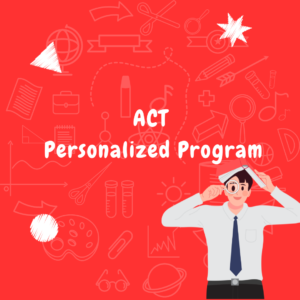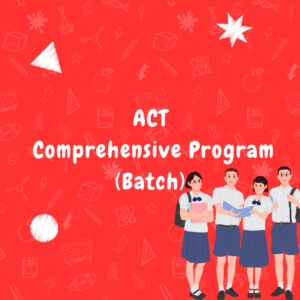The ACT, short for the American College Testing, is a renowned standardised test that plays a pivotal role in college admissions in the United States. Widely recognized for assessing a student’s readiness for college and their academic skills, the ACT has established itself as a vital benchmark in the academic journey. Let’s understand the key aspects of the ACT – comparing it to the Digital SAT, elucidating the registration process, detailing its frequency of administration, and identifying the target audience for this important examination.
How is ACT different from the Digital SAT?
While both the ACT and the Digital SAT are standardised tests used for college admissions, they have distinct structures.
- Test Duration: The Digital SAT is notably shorter, spanning 2 hours and 14 minutes, while the ACT extends to 3 hours and 35 minutes.
- Number of Questions: The Digital SAT presents 98 questions, a significantly smaller count compared to the 215 questions found on the ACT.
- Optional Essay: While the ACT offers an optional essay, the Digital SAT does not include this component.
- Nature of Questions: The ACT features more direct and straightforward questions, whereas the Digital SAT often requires deeper thought and analysis.
- Section Adaptivity: The Digital SAT employs section adaptivity, whereas the ACT follows a fixed format.
- Science Section: The ACT incorporates a Science Section, evaluating students’ scientific reasoning abilities, a component absent from the Digital SAT.
- Scaled Score: On the ACT, each section is scaled out of 36, with the total composite score also out of 36, representing the average of the four sections. In contrast, the Digital SAT assigns scores out of 800 points for each section (Reading & Writing and Math), and the total score is the sum of these three sections, resulting in a maximum total score of 1600.
How can a student register for the ACT?
Registering for the ACT is a straightforward process. Students can create an account on the official ACT website, where they will find comprehensive information about test dates, locations, and fees. They can select their preferred test date and center, pay the registration fee, and choose whether to include the optional Writing section. The online registration system also accommodates students with disabilities, ensuring accessibility for all.
How many times a year is ACT conducted?
The ACT is administered multiple times throughout the year, typically in February, April, June, July, September, October, and December. Click here to view test dates and deadlines.
This frequent schedule offers flexibility for students to choose a date that aligns with their academic calendar and college application deadlines. It’s important to note that test dates may vary by location, so students should consult the ACT website for the most up-to-date information.
Who should take the ACT?
The ACT is an excellent option for high school students seeking to apply to colleges and universities majorly in the United States. Some colleges in India also accept ACT Scores. These colleges and universities consider the ACT score as an important metric and an essential part of the admissions process. Students aiming to demonstrate their academic proficiency, qualify for scholarships, or strengthen their college applications should consider taking the ACT. It’s essential to research the specific requirements of the colleges or universities to which they plan to apply to determine whether the ACT is necessary.
In conclusion, the ACT stands as a significant player in the college admissions process, offering a distinct assessment of students’ academic readiness. Understanding the differences between the ACT and Digital SAT, the registration process, the test’s frequency, and its intended audience is crucial for students and educators navigating the path to higher education.
Click here for more information.
The ACT comprises four main sections: English, Mathematics, Reading, and Science, each with its own allocated time. There is also an Optional Essay. The total duration of the test is 3 hours and 30 minutes including the optional essay. A 15-minute break is scheduled between the Math and the Reading sections.
| Content Domain | Skill/Knowledge Testing Points | Question Distribution | |
| Usage and Mechanics | Punctuations |
|
7–12 questions ~10-15% |
| Grammar & Usage |
|
12–15 questions ~15-20% | |
| Sentence Structure |
|
15–19 questions ~20-25% | |
| Rhetorical Skills | Strategy |
|
12–15 questions ~15-20% |
| Organisation |
|
7–12 questions ~10-15% | |
| Style |
|
12–15 questions ~15-20% | |
| Content Domain | Skill/Knowledge Testing Points | Question Distribution |
| Pre-Algebra |
|
12–15 questions ~20-25% |
| Elementary Algebra |
|
9–12 questions ~15-20% |
| Intermediate Algebra |
|
9–12 questions ~15-20% |
| Coordinate Geometry |
|
9–12 questions ~15-20% |
| Plane Geometry |
|
12–15 questions ~20-25% |
| Trigonometry |
|
3–6 questions ~5-10% |
The paired passages can appear in any of the four topic domains, but it’s worth noting that literary fiction and humanities tend to be the most common areas where you’ll encounter these paired passages.
| Content Domain | Skill/Knowledge Testing Points | Question Distribution |
| Key Ideas and Details |
|
15–20 questions ~40-55% |
| Craft and Structure |
|
9–12 questions ~20-30% |
| Integration of Knowledge and Ideas |
|
5–8 questions ~15-20% |
The ACT Science section involves questions related to Biology, Chemistry, Physics, Space Science, and Earth Science. Questions regarding these topics are presented within passages and fall into the following passage types in the ACT Science:
- Data Representation: These passages feature scientific articles accompanied by charts and tables, prompting questions related to data interpretation.
- Research Summary: These passages describe experimental procedures, evaluating comprehension of the scientific method and experimental design.
- Conflicting Viewpoints: In these passages, two or more differing explanations of a scientific phenomenon are presented, requiring assessment of models, inferences, and experimental results.
| Content Domain | Skill/Knowledge Testing Points | Question Distribution |
| Data Representation |
|
12–16 questions ~30-40% |
| Research Summary |
|
15–20 questions ~40-55% |
| Conflicting Viewpoints |
|
5–8 questions ~15-20% |

Our Approach
We begin with organising the Diagnostic Test to understand the following:
- Whether the student is better suited for Digital SAT or ACT.
- The starting point for a particular student in comparison to the peers..
- Determine the student’s potential and set realistic goals for the final test.
Phase 1 : The Learning Phase
During this phase, the students are taught the basics! They learn various concepts, rules, and techniques to master each section of the ACT! Homework is given to the students after every class to strengthen their concepts and ensure they are working towards their goals.
Phase 2 : The Practice Phase
We also call this a Confidence Building Phase. This is a very crucial phase as the students realize their strengths and areas of weaknesses. We give additional practices to the students for every section along with Sectional Tests. Subsequently, students come across various doubts and the Doubt Classes happen during this phase, resulting in a surge in the confidence level of every student.
Phase 3 : The Mock Phase
Post completion of the Practice Phase, the student is conditioned for the actual test! Until now, he/she was just sprinting! Now the real marathon starts! The student takes 20 Full Length Digital ACT Mocks before the 1st Attempt of the ACT.
Not just that, after every attempt the student has to do the analysis using the answer guide to understand his/her mistakes. We organise 2 Mock Review Sessions every week, in which the teacher helps the student identify the root cause of the mistakes and problems so that they could be avoided going forward. These Mock Review Sessions are 1:1 regardless of whether you signed up for a batch or 1:1 program.
Additional benefits of enrolling with LessonBoard
- Individual WhatsApp group with each family for regular updates.
- Comprehensive Books and Material
- 20 ACT Mocks with actual test interface for accurate practice.
- Regular Parent-Teacher Meetings to track the student's progress
- Unlimited Doubt Classes
- Hand holding the student till 2nd attempt or 1 year, whichever is earlier.
- Money Refund Promise (Read our refund policy)


